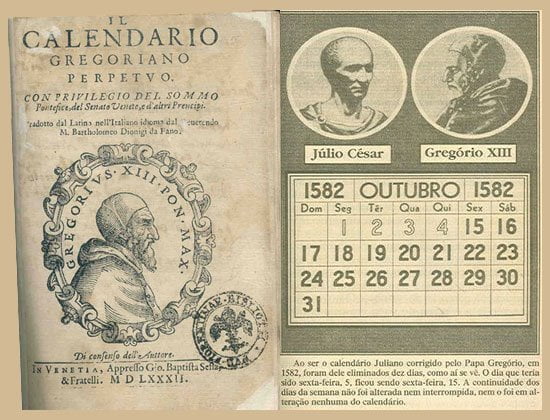At present, for the time change in spring, it is established each year that at 02:00 in the morning of a Saturday it passes to three o'clock, producing that day there is one hour less. Well, in the year 1582 a similar event occurred since Pope Gregory XIII, advised by the Jesuit astronomer Christopher Clavius promulgated, on February 24, 1582, the bull Inter Gravissimas in which he established that after Thursday, October 4, 1582 It would continue on Friday, October 15, 1582. In this way, that day the inhabitants of Italy, France, Spain and Portugal went to sleep to wake up ten days later, exactly on October 15.
What was the reason for that change: the offset of the calendar with the solar year. Until that day, the Julian calendar was in force, established in the year 46 BC by Julius Caesar. The Julian had a small error, because
established the length of the year at 365 days and 6 hours, when in reality it was 365 days, 5 hours, 48 minutes and 45 seconds.
In 1582, the Julian year was 11 minutes and 14 seconds more than the solar year, which caused the accumulated difference to bring the spring equinox forward by ten days. It was a lag of almost 10 days in the more than 1.600 years that it was in force. By canceling those ten days, the gap disappeared and so that it would not occur again, three leap years every four centuries were eliminated in the new calendar. In this way arose the
Gregorian calendar with three types of years: the common year of 365 days, the leap year with 366 days and the secular year, which is a year that closes the century (multiples of 100 are secular years, and therefore end in two zeros:
100, 200, 1500, 2000, etc…).
To avoid chronological lag, the Gregorian calendar established for the future that only secular years that are divisible by 400 will be leap years.
The Gregorian calendar came into force immediately in Catholic Europe and later spread to other countries. Protestant areas did not do so until 1700, Great Britain until 1753, Japan in 1873 and the then Soviet Union in 1918. Some Orthodox churches still follow the Julian calendar.
Book Day date
Royal Decree 307/1993 and the resolution of the General Conference of UNESCO, the highest international organization in the field of culture and education, of November 15, 1995, declared April 23 as World Book and Copyright Day. . In Spain we already said that such a celebration was established in 1926 at the initiative of Vicente Clavel.
In the text of the declaration it is specified that April 23 is chosen because that date in the year 1616 coincides with the death of Miguel de Cervantes, the Inca Garcilaso de la Vega and William Shakespeare, greatest exponents of literature in the Spanish language and english.
Apparently, the widespread mistake of believing that Cervantes and Shakespeare died on the same day was made by Dr. John Bowle, the first English commentator on Cervantes' work. The diffusion of him is due to Victor Hugo, who certified that apparent coincidence at the end of his William Shakespeare, where he says: “he died on April 23. He was exactly fifty-two years old that day, since he was born on April 23, 1564. This same day, April 23, 1616, Cervantes died, a genius of the same height.
The French author did not take into account that in 1616, in Spain, the correction of the calendar established in 1582 by Pope Gregory XIII was already in force, while in England the old Julian calendar continued in force, then delayed by about eleven days with respect to time. real. Only in 1752, the House of Peers approved the proposal presented by Lord Chesterfield on March 20, 1751, in which he argued that England should adopt the Gregorian correction of the calendar. In this way, in the British dominions the month of September 1752 had only nineteen days.
Therefore, according to the corrected calendar, Shakespeare would not have died on April 23, but on May 3, 1616. This is stated by Astrana Marín in her biography of the English author, where it can be read: "And he dies on Tuesday, April 23 of 1616 (May 3 of our calendar), ten days after another genius of the same size, our immortal Cervantes, went down to the grave.
Shakespeare's death coincided with the date, April 23, popularly regarded as the death of Miguel de Cervantes. However, in reality Cervantes, although he was buried on April 23, had died the day before. On the other hand, the death of Shakespeare and the burial of Cervantes did not take place on the same day either.
In reality, Shakespeare's death took place several days after Cervantes' (depending on the authors, it is dated on May 3 or 4 of the Gregorian calendar).
As for Inca Garcilaso de la Vega, he died in Córdoba on April 22, 1616, ten days after he was 67 years old. His body is buried in the Mosque-Cathedral of Córdoba.
This was also confirmed by Carlos Mayoral, a Spanish philologist and author of the book 'I begin to believe that it is a lie', who describes as 'myth, posturing and marketing' to make the two deaths coincide. In the case of Valencia, the Valencià Book Day has also been celebrated since the year 2000, set on November 20 on the date that coincides with the publication of the first edition of Tirant lo Blanc that took place in 1490.
Cervantes reminded this work in the mouth of the priest of his Quixote, and defined it as a "treasure of contentment and mine of pastimes", as well as, due to its style, "the best book in the world".
To finish we join Cervantes who writes "he who reads a lot and walks a lot, sees a lot and knows a lot".
Juan Bta. Bas Codina







